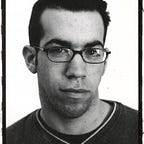An Introduction to Hebrew Type
This article presents in brief the typographic fundamentals of the Hebrew script. If you’re thinking about working with Hebrew type, or drawing Hebrew letters yourself, here are the main things you have to know:
Hebrew is a relatively lean alphabet, with 22 letters and 5 additional final forms, which are versions of letters that appear only at the end of words. The script includes some unique punctuation & diacritical marks, which will be discussed further down this article.
The most obvious feature of the script is its direction — horizontal rows of text that flow from right to left. This also affects the letters’ geometry: for example, the “open letterforms”, as they are called, are open on their left side; the tops of the letters curve towards the left, as well.
For most of the writing models, the pen is usually held at an angle of about 60º to the baseline, which creates heavy horizontal strokes and thin vertical strokes. Some modern styles are drawn at a 45º angle, making an even stroke throughout.
Hebrew letters hang from the top line, rather than rest on the baseline. This top line is called the ם (mem) height (similar to the Latin x-height).
Hebrew has one ascender — in the letter ל (lamed). It’s traditionally at least as tall as an entire mem height, but in modern typography it’s usually shortened to save space. In cursive Hebrew some letters are stylistically drawn taller, such as tet and shin, but this is more of an exception than a rule.
There are five Hebrew descenders — in the letter ק (qof), and in four of the five final forms — ך (kaf), ן (nun), ף (pe) and ץ (tsadi). Historically, the ם (final mem) also descended below the baseline, but in modern Hebrew it’s aligned to the baseline.
Hebrew letters have three widths: “closed” letterforms (that have two or more vertical strokes enclosing their counters) are the widest; “open” letterforms (with a single vertical stroke on their right side) are a bit more compact; and the narrowest letters are the ones with minimal horizontal strokes, such as vav and yod.
The Hebrew script has two forms: square (formal) and cursive. There is also a medial form that was used for rabbinical interpretive texts (earning the nickname rashi script), and which is illegible to most readers today. Hebrew has no “cases” (no minuscules/majuscules) nor italics. The formal and cursive forms are almost never used together. An emphasis in Hebrew will usually be rendered in bold. There have been few attempts to create a Hebrew equivalent to the italic style; the most successful one was the cursive style of the David Hebrew typeface by Ismar David.
The concept of serifs/sans-serifs is foreign to Hebrew. More about this discussion can be read in this article I wrote about Hebrew serifs.
Hebrew is an abjad — a consonant-only script. Vowels are normally inferred, and sometimes are marked in the form of diacritical marks, niqqud. These marks are usually attached to the bottoms of the letters, except for one that is inserted within the counters (dagesh) and some that appear above the letters (holam and the rafé mark, and the shin/sin dots). The marks are usually styled in accordance to the main letterforms. Niqqud marks have standard Unicode numbers, and Hebrew text fonts normally include them. There is also a separate set of cantillation marks, which is used exclusively for biblical texts, and is rarely included outside of traditional “biblical” fonts.
Hebrew has some specific punctuation marks: single and double quote marks—geresh and gershayim—appear “typewriter style” (without direction) and are aligned slightly above the mem height. The Hebrew hyphen, maqaf, which is used to connect words, is a short horizontal stroke aligned to the top of the mem height, forming a “bridge” between the words. Hebrew only has a single dash mark (usually the en dash), set with spaces before and after to denote an independent clause, or without spaces to denote a range. Periods are sometimes diamond-shaped to fit the style of the letterforms, and question- and exclamation-marks are often aligned a little above the mem height.
For further reading, the best book on the subject is Ada Yardeni’s The Book of Hebrew Script, which is a comprehensive illustrated study of the history and the construction of Hebrew letterforms, and is considered to be the “bible” of Hebrew scholarly research. Additionally, L. F. Tobi’s The Art of Hebrew Lettering has some fine examples of different scripts, and Ismar David’s The Hebrew Letter is a wonderful primer for Hebrew writing.
To learn more about the Hebrew script, take my workshop at ATypI 2018 Antwerp this September, in which I guide participants on how to properly write each letter and show examples of historic and modern Hebrew styles.
